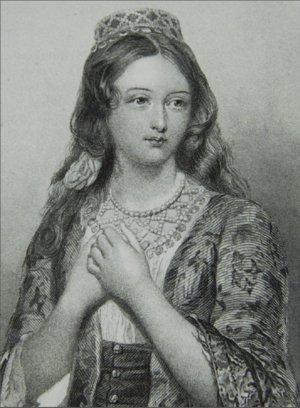María Ignacia Rodríguez de Velasco y Osorio Barba facts for kids
María Ignacia Rodríguez de Velasco y Osorio Barba (1778 – 1851), often called la Güera Rodríguez, was a very important woman in Mexico City society. She was known for her beauty and intelligence. She strongly supported Mexico's independence from Spain.
She married José Jerónimo López de Peralta de Villar Villamil in 1794. He passed away eleven years later.
Because she supported independence, she was questioned by a special court called the Inquisition. After her hearing, the Viceroy Francisco Javier de Lizana y Beaumont sent her away to Querétaro for a short time.
María Ignacia was a good friend of Agustín de Iturbide, who later became the first emperor of Mexico. She also admired the famous German scientist and explorer Alexander von Humboldt. People say that a statue of the Virgin Mary in the church of La Profesa, made by the artist Manuel Tolsá, looks like her.
She married two more times, first to Mariano de Briones and then to Manuel Elizalde. In her later years, she became very religious. After she passed away, her last husband, Manuel Elizalde, became a priest.
Her life was so interesting that Artemio del Valle Arizpe wrote a book about her called La Güera Rodríguez in 1949. A Mexican movie with the same title was made in 1978, where Fanny Cano played María Ignacia.
Contents
Early Life and Family
María Ignacia was born in Mexico City on November 20, 1778. Her parents were Antonio Rodríguez de Velasco and María Ignacia Osorio Barba y Bello Pereyra. She had a sister named María Josefa.
In September 1794, she married José Jerónimo López de Peralta de Villar Villamil. This marriage was arranged with the help of the viceroy Juan Vicente de Güemes, 2nd Count of Revillagigedo. María Ignacia and José Jerónimo had four children together.
A Well-Known Figure
María Ignacia became very famous in New Spain (which is now Mexico) because she was beautiful and very clever. Travelers from other countries even compared her to important European figures. Guillermo Prieto, a writer from that time, said she was known not just for her looks but also for her sharp mind and high position in society.
Some people believe that the statue of Our Lady of Sorrows in the Temple of San Felipe Neri "La Profesa" church was made to look like María Ignacia. This statue was created by the famous artist Manuel Tolsá. Another statue in the same church, the Inmaculada (meaning Immaculate Conception), might even be based on her daughter.
Even when she was older, María Ignacia was still admired. A traveler in the 1840s said she was "very agreeable" and like a "living chronicle" of the past. She still had beautiful fair hair, white teeth, bright eyes, and a lively personality.
Support for Independence
María Ignacia strongly supported the idea of Mexico becoming independent from Spain. She helped the Mexican rebels by giving them money and using her connections with powerful people.
Because of her support for independence, she was called before the Inquisition, a special court. The charges against her were eventually dropped because there wasn't enough proof. After this, Viceroy Francisco Javier de Lizana y Beaumont sent her away to Querétaro for a short time.
She had a close relationship with Agustín de Iturbide, who would later become the first emperor of Mexico. She had a lot of political influence over him. Her connections allowed her to see important secret documents. For example, she saw a letter from King Ferdinand VII to Viceroy Juan José Ruiz de Apodaca in 1820. This letter suggested finding a popular military leader to negotiate with the rebels. María Ignacia believed that Iturbide was the right person for this important role. This idea helped lead to the Plan of Iguala, which was a key step towards Mexico's independence.
Friendships and Later Life
María Ignacia was also friends with Alexander von Humboldt, a famous German naturalist and explorer. Their friendship began when she invited him to see a special plant farm. After that, they were often together. It is recorded that she was with Humboldt when a large statue of Charles IV of Spain was unveiled.
In her final years, María Ignacia dedicated herself to religious life as part of the Third Order of Saint Francis. She passed away on November 1, 1850, in Mexico City. After her death, her last husband, Manuel de Elizalde, became a priest.
Legacy and Portrayals
Her fascinating life inspired Artemio de Valle Arizpe to write a biographical novel about her, called La Güera Rodrígez, in 1949. In 1978, Mexican actress Fanny Cano played María Ignacia in a film also titled La Güera Rodríguez, directed by Felipe Cazals.
See also
 In Spanish: María Ignacia Rodríguez de Velasco para niños
In Spanish: María Ignacia Rodríguez de Velasco para niños


